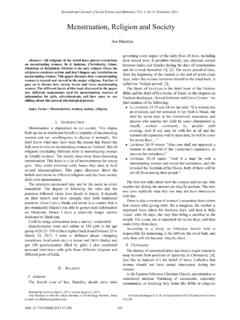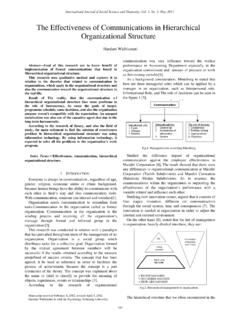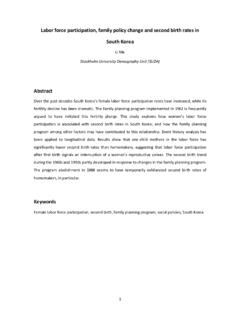Transcription of Women’s Labor force Participation in Sri Lanka: An Inquiry ...
1 International Journal of Social Science and Humanity, Vol. 7, No. 3, March 2017. Women's Labor force Participation in Sri Lanka: An Inquiry into the Factors Influencing Women's Participation in the Labor Market Wanninayake M. Semasinghe (ILO - /. Abstract The main objective of this study was to identify the lang-- accessed January, 2016). Full utilization contributory factors that obstruct women from entering the of all resources available in a country is critical to achieve Labor market at the micro level. The study was based mainly on and sustain a high level of growth in that country. Labor force the mixed method approach. A sample survey method was Participation is one of the crucial areas to which much employed to collect data in order to achieve the main objective while data generated by Quarterly Labor force Surveys were attention must be paid in this regard. The higher the Labor employed to achieve the other objective. force Participation rate, the higher the percentage of the As analysis revealed involvement in household activities is country's working age population involved in the Labor the major factor common to all three sectors.
2 Other factors that market. In fact, the Labor force Participation rate is not only were identified were engagement in studies, voluntarily an economic indicator but also an attribute that links with abstaining from working in order to enjoy leisure, sufficiently many other aspects of human life, particularly in the less high level of household income to preclude the need for an developed countries. additional income, bad environment in the work place, unfavorable working conditions, socio-cultural constraints, Though female Labor force Participation (FLFP) is physical illness/disability, having retired, low wages, family generally lower compared to that of the males in all countries, decision, lack of employment opportunities, low education level, it is unusually low in some developing countries in absolute backward attitudes, lack of awareness about the employment terms as well as when compared to the EU and OECD. opportunities and lack of skills to cope with available standard1.
3 Low FLFP means that a substantial proportion of opportunities. Among these, the first three are common to the working age females is not contributing to the national urban and rural sectors while the last four factors are specific to the estate sector. economy. The low rate of FLFP reflects to some extent the country's Labor related economic imbalance as well as its Index Terms Economic development, female Labor force social and cultural norms. Further, it mirrors the gender Participation , social development, Sri Lanka, U-hypothesis. inequality in employment opportunities and to the state of the peoples' Participation in economic activities. In fact, gender inequality continues to be one of the key socioeconomic I. INTRODUCTION concerns of many international organizations, social activists, Labor force Participation means the active engagement or women's movements, NGOs etc. over the decades, all of willingness of people of working age to engage in economic which emphasize the demand that equal opportunities should activities included in the System of National Accounts (SNA).
4 Be available to women. As a consequence, national policies The size of the Labor force in a country depends on the have been put in effect in many developing countries giving number of individuals of working age participating in the priority to promote gender equality so as to empower women. Labor market. The proportion of economically active persons female Labor force Participation rate of a country is one of the of a country relative to the total working age population is key indicators that reflect women's contribution to the expressed as the Labor force Participation rate (LFPR). economy. If the rate is close to that of the males' Participation Engagement in any activity for pay, including rate, then women can be said to have opportunities equal to self-employment that produces some product or service for that of men in contributing to the economy. the market or for consumption within the household is In the case of Sri Lanka, the female Labor force considered as Labor force Participation but not the services Participation rate is much lower in both absolute as well as such as looking after own child, general housework etc.
5 Relative terms when compared to the countries in the region Further, individuals who are not employed but are willing to and many other distant but comparable countries. By 2014. work and actively seeking employment in SNA activities are the rate was around 35 present. This means that only about 35. also included [1]. As this includes all economically active out of every 100 women in the working age category individuals, it indicates the relative size of the Labor pool participated in the Labor market. There are considerable available to engage in the production of goods and services sector differences in the FLFP of the country. Although Labor force Participation of women in the estate sector is as high as Manuscript received April 25, 2016; revised June 29, 2016. This work is 52 per cent, it is only 35 per cent and 30 per cent respectively supported by the Faculty Development Fund of the Faculty of Social in the rural and urban sectors [2]. In contrast to the FLFP, Sciences.
6 Wanninayake M. Semasinghe is with the Department of Economics, male Labor force Participation (MLFP) in the country is as University of Kelaniya, Box, 11600, Sri Lanka (e-mail: doi: 184. International Journal of Social Science and Humanity, Vol. 7, No. 3, March 2017. high as in other countries. In fact, it has been twice as high as phenomena. the FLFP rate from the time records have been kept. As the An empirical model was formulated to identify the impact World Bank points out Sri Lanka reports the 28th largest of selected macro level factors on women's Labor force gender gap in Labor force Participation . Teignier and Cuberes Participation . Based on the literature and the data availability, [3] have estimated that the loss of per capita income due to the following factors, viz. education level of female (ED), gender gaps in employment, self-employment, Labor force fertility rate (FR), urbanization (UR), GDP growth rate Participation and wages is 20 per cent.)
7 (GDP), female unemployment rate (UN) and male Labor force During the past two or three decades Sri Lanka has Participation rate (MLFP) were selected as explanatory achieved remarkable progress in social development, variables. accompanied by modest economic growth. Gender inequality The following model was then formulated under the in many fields including access to education, health, assumption that the relationship between FLFP and other employment opportunities etc. has declined significantly and variables is linear: many other aspects of social development relating to females have also improved. Moreover, there is no significant FLFPt 0 1 EDt 2 FRt 3 URt 4 GDPt 5 UNt 6 MLFPt t discrepancy in educational attainment between younger men and women; the fertility rate is significantly low. As reported This model is to be fitted with the secondary data collected by the Global Gender Gap Report (2010) of the World from the Labor force Surveys (LFSs) of the Department of Economic Forum, Sri Lanka is among the top 20 countries in Census and Statistics (DCS), and from the reports of the the world in gender equality.
8 Meanwhile, Sri Lanka is at a Central Bank of Sri Lanka (CBSL). In order to identify the transitional stage of economic development with a shrinking factors that prevent women from participating in the Labor agricultural sector and gradually rising industrial and service force , a sample survey was carried out. Sampling design was sectors. Under this circumstance, the FLFP is expected to based on the quota sampling method and the overall sample increase in keeping with the traditional U-hypothesis. Amidst size was 250 units. Sampling units were the women between these favorable circumstances it is puzzling to observe that 15 and 64 years of age who were not participating in the Labor the FLFP rate is as low as 35 percent. In fact, this rate is market. One hundred women from the urban sector, one comparatively much lower than what one would expect given hundred from the rural sector and fifty from the estate sector the high level of women's educational attainments and were selected purposively.
9 A structured questionnaire was progressive achievements in other aspects of social used to collect data from the selected sampling units. development. Although Sri Lanka is ahead of other South Asian countries in terms of human and social development, when it comes to female Labor force Participation it III. DETERMINANTS OF female Labor force . surprisingly ranks at the same level as other South Asian Participation : A LITERATURE REVIEW. countries. In this context, the question that arises is why the A substantial volume of literature on the empirical and FLFP rate is very low even though the necessary conditions theoretical analysis of the trends, determinants, obstacles etc. that stimulate female Labor force Participation have gradually of the Labor force Participation was studied employing improved over the past two-three decades? Hence, this study various methodologies and different datasets. Among those, mainly focuses on identifying the factors that obstruct interest was laid mainly on the examination of the women from entering the Labor market at the micro level.
10 In relationship between female labour force Participation (FLFP). this endeavor an attempt will be made to examine whether and economic development as dealt with in the pioneer works there are any sector differences in these factors. In addition, of Mincer [4] and Cain [5]. This relationship is described by the study will attempt to quantify the impact of key the so-called U-hypothesis. According to this hypothesis, the determinants on FLFP in Sri Lanka at the macro level. FLFP rate is high during the initial phase of economic development mainly in agrarian societies due to the close II. RESEARCH APPROACH AND DATA linkage between households and the production process. Although the fertility rates are still high women work in This study is based mainly on the mixed method approach. family farms or household enterprises while engaging in This is because in order to attain the desired objectives both childcare. When the economy moves from agricultural to qualitative data as well as quantitative data are required.


















